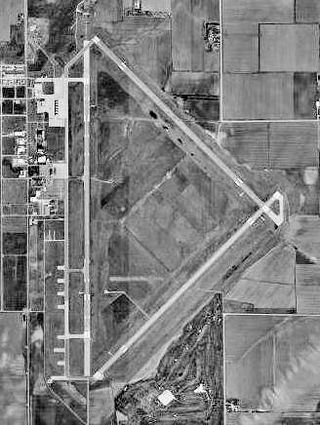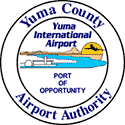Jack Brooks Regional Airport, formerly Southeast Texas Regional Airport, is near Port Arthur, Texas, nine miles (14 km) southeast of Beaumont and northeast of Port Arthur. It was Jefferson County Airport, but its name was changed to honor former U.S. Representative Jack Brooks. The airport is southwest of the city of Nederland in unincorporated Jefferson County, and is used for general aviation. Southwest Airlines ended scheduled jet service in 1980 and several other airlines have started and ended service as well including American Eagle, Continental, Delta/Delta Connection and United Express. The latest chapter is the resumption of service by American Eagle for American Airlines to Dallas/Ft. Worth (DFW).

Allegheny Airlines was a local service carrier that operated out of Pittsburgh, Pennsylvania, from 1952 to 1979, with routes primarily located in the eastern U.S. It was the forerunner of USAir that was subsequently renamed US Airways, which itself merged with American Airlines. Its headquarters were at Washington National Airport in Arlington County, Virginia.

Ely Airport is a county-owned airport three miles northeast of Ely, in White Pine County, Nevada, United States.

Imperial County Airport is a county-owned public-use airport in Imperial County, California, United States. Also known as Boley Field, it is mostly used for general aviation, but has scheduled passenger service from one commercial airline. Service is subsidized by the Essential Air Service program. The airport is located 1 nautical mile south of the central business district of Imperial, California, partially in the city of Imperial and partially in an unincorporated area of Imperial County. It serves nearby communities, including El Centro.
Sheridan County Airport is located in Sheridan County, Wyoming, approxiametly two miles southwest of the city of Sheridan, Wyoming. It serves both commercial and general aviation, as well as military aircraft.

Eastern Oregon Regional Airport is a public airport three miles northwest of Pendleton, in Umatilla County, Oregon, United States. Commercial service is provided by Boutique Air to Portland, subsidized by the Essential Air Service program.

Central Nebraska Regional Airport is three miles northeast of Grand Island, in Hall County, Nebraska. It is owned by the Hall County Airport Authority. The airport sees two airlines, Allegiant Air which flies independently and American Eagle which is subsidized by the federal Essential Air Service program. In 2016 the airport had 68,879 passenger boardings (enplanements), a 6.6% increase from the 64,602 enplanements in 2015. The airport had 7,961 enplanements in calendar year 2008, 20,136 in 2009 and 37,101 in 2010.

Huron Regional Airport is in Huron, in Beadle County, South Dakota. The airport has charter passenger flights operated by fixed base operator (FBO), Fly Jet Center and Revv Aviation. Revv Aviation wants to bring all services to Huron including maintenance, avionics, flight school and charter.

Four Corners Regional Airport is in San Juan County, New Mexico, United States, in the city of Farmington, which owns it. It is a Class D towered general aviation airport with no commercial passenger services, but has chartered flight services, flight instruction, and a full-service fixed-base operator]] (FBO). It is included in the Federal Aviation Administration (FAA) National Plan of Integrated Airport Systems for 2019–2023, in which it is categorized as a regional general aviation facility.

Cavern City Air Terminal is a public use airport in Eddy County, New Mexico, United States. It is owned by the city of Carlsbad and located five nautical miles southwest of its central business district. The airport is served by one commercial airline, with scheduled passenger service subsidized by the Essential Air Service program.

Yuma International Airport is a joint use airport with civilian and military flight activity operated in conjunction with the U.S. Marine Corps via the Marine Corps Air Station Yuma. The airfield is located 3.5 miles south of the central business district of Yuma, a city in Yuma County, Arizona, United States, and 150 miles east of San Diego International Airport. It is mostly used for military aviation, but is also served by one commercial airline and one aeromedical Medevac company as well as being used for general aviation activities.

Flagstaff Pulliam Airport is 5 miles south of Flagstaff, in Coconino County, Arizona, United States. The airport is serviced by American Eagle, and is also used for general aviation. The National Plan of Integrated Airport Systems for 2011–2015 called it a "primary commercial service" airport. It is the closest airport to Grand Canyon National Park with scheduled passenger service from a major airline.

Grand Junction Regional Airport is three miles (4.8 km) northeast of Grand Junction, in Mesa County, Colorado, United States. Owned by the Grand Junction Regional Airport Authority, it is the largest airport in western Colorado and third largest in the state, behind Denver International Airport and Colorado Springs Airport.

Durango–La Plata County Airport is a city- and county-owned public airport 12 miles southeast of Durango, in La Plata County, Colorado.

Williamsport Regional Airport serves Williamsport, Pennsylvania, and the surrounding area with a population of roughly 200,000. The airport processes approximately 40,000 passengers annually and has served north central Pennsylvania since 1929.

Muskegon County Airport is a county-owned, public-use airport in Muskegon County, Michigan, United States. The airport is located four nautical miles south of the central business district of Muskegon, Michigan, in Norton Shores. It is mostly used for general aviation but is also served by Southern Airways Express flying Cessna 208 Caravan aircraft to Chicago-O'Hare, subsidized by the Essential Air Service program.

Hutchinson Municipal Airport is a city-owned public airport three miles east of Hutchinson, in Reno County, Kansas, United States.

Vernal Regional Airport is a mile southeast of Vernal, in Uintah County, Utah. It is owned by the city and county and sees one airline, subsidized by the Essential Air Service program.

Britt Airways was a regional airline in the United States that operated from 1964 until it merged with ExpressJet in 1996. It was established as Vercoa Air Service in 1964 and renamed to Britt Airlines when it was purchased by William and Marilyn Britt in 1975 later on Britt Airways. It was based in Terre Haute, Indiana until 1996. It began as a commuter airline. It primarily operated turboprop aircraft but also flew British Aircraft Corporation BAC One-Eleven twinjets as an independent air carrier at one point as well. The airline evolved into a regional air carrier operating code share flights primarily for Continental Airlines.
Wings West Airlines was an American regional airline headquartered at McChesney Field (SBP), unincorporated San Luis Obispo County, California. The airline initially began scheduled passenger service as an independent commuter air carrier and then subsequently became an American Eagle affiliate of American Airlines operating turboprop aircraft on code sharing flights on behalf of American.



















